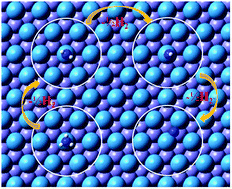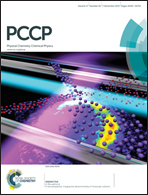Computational investigation of NH3 adsorption and dehydrogenation on a W-modified Fe(111) surface
Abstract
Hydrogen gas will play an important role in the future since it could be a replacement for gasoline, heating oil, natural gas, and other fuels. In previous reports ammonia (NH3), which has a high hydrogen content, provides a promising mode for the transferring and storing of hydrogen for its on-site generation. Therefore, the dehydrogenation of NH3 on a metal surface has been studied widely in the last few decades. In our study, we employed monolayer tungsten metal to modify the Fe(111) surface, denoted as W@Fe(111), and calculated the adsorption and dehydrogenation behaviors of NH3 on W@Fe(111) surface via first-principles calculations based on density functional theory (DFT). The three adsorption sites of the surface, top (T), 3-fold-shallow (S), and 3-fold-deep (D) were considered. The most stable structure of the NHx (x = 0–3) species on the surface of W@Fe(111) have been predicted. The calculated activation energies for NHx (x = 1–3) dehydrogenations are 19.29 kcal mol−1 (for H2N–H bond activation), 29.17 kcal mol−1 (for HN–H bond activation) and 27.94 kcal mol−1 (for N–H bond activation), and the entire process is exothermic by 33.05 kcal mol−1. To gain detailed knowledge of the catalytic processes of the NH3 molecule on the W@Fe(111) surface, the physical insights between the adsorbate/substrate interaction and interface morphology were subjected to a detailed electronic analysis.


 Please wait while we load your content...
Please wait while we load your content...